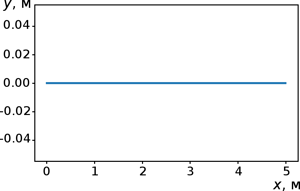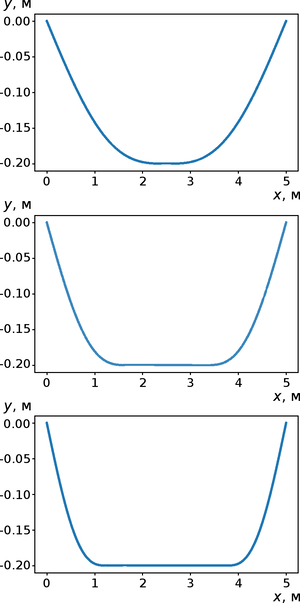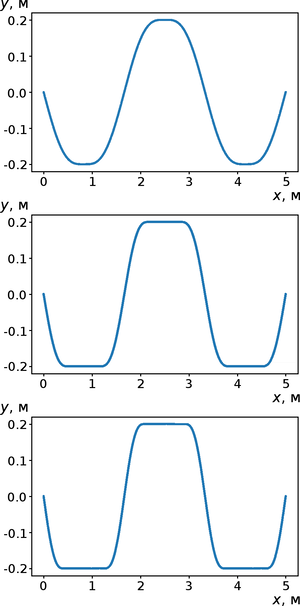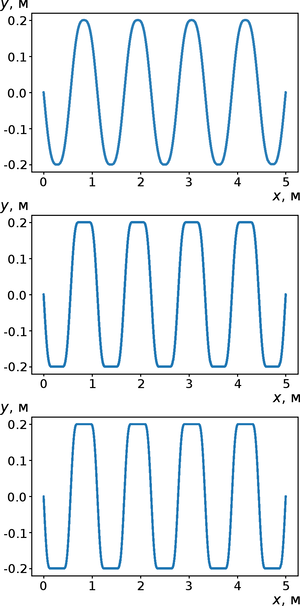Makarov M.I., Kuzmin I.L.
Pipeline stability under longitudinal and transverse bending in a plane channel. Multiphase Systems. 2025;20(2):98–104 (in Russian).
Pipeline stability under longitudinal and transverse bending in a plane channel
M.I. Makarov
1,2 🖂, I.L. Kuzmin
31Skolkovo Institute of Science and Technology, Moscow, Russia
2National Research University Higher School of Economics, Moscow, Russia
3Bauman Moscow State Technical University, Moscow, Russia
Abstract
The study is devoted to the urgent problem of the stability of rods in a confined space, which is important for the technologies of drilling
wells and the construction of underground passages using directional drilling. The aim of the work is to determine the spectrum of critical
forces corresponding to the various forms of contact of the rod with the flat walls of the channel. Based on the classical Euler-Bernoulli
bending theory, an analytical model of a weightless rod between two rigid flat surfaces has been developed. This made it possible to obtain
precise formulas for calculating the critical forces at which the rod loses stability. Numerical simulation is performed using the collocation
method with adaptive grid selection implemented in the solve_bvp function of the SciPy library. This method allows you to take into
account complex boundary conditions and nonlinear effects that can affect the stability of the rod. As a result of the study, seven different
forms of rod bending and their corresponding ranges of critical forces were determined — from
Pcr = π2EJ/l2 to Pcr = 1296π2EJ/l2.
The patterns of transition from point contact to linear contact with increasing load are revealed. It is established that at low loads the rod bends
in the form of a sine wave, and at high loads it takes on more complex shapes, including shapes with several half—waves. The resultsobtained are in good agreement with experimental data, which confirms their reliability and practical significance. The results of the study
can be used in the design of pipelines in the oil and gas industry to prevent the loss of structural stability. This is especially important
when laying pipelines in difficult geological conditions, where the stability of the rods may be compromised due to high loads or space
constraints. In addition, the results of the study may be useful in the development of new technologies for drilling and construction of
underpasses. For example, they can be used to optimize the parameters of drilling equipment and the construction of underpasses to
ensure their stability and reliability. Further research in this area may be aimed at studying the stability of rods, taking into account the
influence of temperature, humidity and other factors that may affect their properties and behavior in a confined space. This will make
it possible to develop more accurate and reliable methods for designing and operating structures in difficult conditions.
Keywordslongitudinal-transverse bending,
pipeline stability,
flat channel,
critical force,
point contact,
line contact
Article outline
The classical problem of the stability of a rectilinear rod compressed at both ends is well known and it is the starting point for formulating many problems of rod stability. One of them is the problem of the stability of a rod located between two rigid plane surfaces.
Currently, rod mechanics has found wide application in practical pipeline installation tasks in the oil and gas industry. The bending and post-bending behavior of pipes (such as drill string, casing, well test pipe and coiled tubing) in a well has a great impact on many aspects of petroleum engineering, which include the functions of pipes, the safety and accuracy of downhole surveying tools, the deformation and bending stresses of pipes, the contact and friction forces with the wellbore, the limitations of drilling at increased depths and so on. Therefore, the study of the buckling behavior is of vital importance to the science and technology of petroleum engineering and related fields.
In this paper, we study a pipeline located in a well that has the form of a flat channel, assuming that a longitudinal load P is applied along the edges. This problem is relevant when laying a pipeline and allows us to calculate the stresses that may arise in the pipe.
The objectives of this study are to determine what types of elastic lines are formed and to construct a model.
Methodology. Based on the solution of the longitudinal-transverse bending problem, a sequence of critical values of the force compressing a rod located between two rigid plane walls was determined. The problem was solved in the approximation of a weightless rod, when its weight can be neglected compared to the magnitude of the applied force, which is true for elements of very rigid structures. Another important condition was that initially the rod did not lie on any of the planes and did not touch them, and subsequently the coefficient of resistance of the base was also not taken into account. In the process of solving the problem, the fact of contact between the rod and the wall required an additional boundary condition necessary to determine the section of the rod from its boundary to the point of contact.
Findings. Seven forms of rod bending and corresponding ranges of critical force variation were found (P̃ = P/Pcr is dimensionless force):
- at 0 ≤ P̃ ≤ 1 the rod does not bend due to insufficient force;
- at 1 ≤ P̃ ≤ 4 bending occurs with contact at one point – the middle of the rod, which has the lowest rigidity;
- at 4 ≤ P̃ ≤ 16 contact with the wall occurs, the length of which is proportional to the force;
- at 16 ≤ P̃ ≤ 36 secondary loss of stability occurs in the middle section, and 3 bending half-waves are formed, each of which touches the wall;
- at 36 ≤ P̃ ≤ 144 each half-wave forms linear contact with the wall;
- at 144 ≤ P̃ ≤ 324 loss of stability occurs in the middle sections of the half-waves and formation of 9 half-waves;
- at 324 ≤ P̃ ≤ 1296 linear contact appears again at each half-wave.
Originality. This paper presents the results of determining the spectrum of critical forces corresponding to the number of rod contacts with flat walls. A comparison with experimental data from laboratory tests is provided.
References
- Феодосьев ВИ. Избранные задачи и вопросы по сопротивлению материалов. 5-е изд., испр. и доп. М.: Наука, Физматлит; 1996. 368 c.
Feodosyev VI. Selected Problems and Questions in Strength of Materials. Beekman Books Inc.; 1977. 432 p.
- Овчинников НТ, Сорокин ФД. Численное и физическое моделирование деформирования стержня при осевом нагружении в канале. Часть 1. Инженерный журнал: наука и инновации. 2020;10(106):1–23.
Ovchinnikov NT, Sorokin FD. Physical modeling and numerical simulation of bar deformation under axial loading in the channel. Part 1. Engineering Journal: Science and Innovation. 2020;10(106):1–23 (in Russian).
DOI: 10.18698/2308-6033-2020-10-2021
- Биргер ИА, Пановко ЯГ. Прочность, устойчивость, колебания. Справочник. В 3-х томах. М.: Машиностроение, 1968; 415 с.
Birger IA, Panovko YaG. Strength, Stability, Vibrations. Handbook. In 3 volumes. Moscow: Mashinostroenie; 1968. 415 p. (in Russian).
- Zhang Y, Shu J. Numerical modeling and the ultimate bending experiment of the directional drill pipes bending at the dog-leg of the multi-branch well. Heliyon. 2024;10(19):e38314. DOI: 10.1016/j.heliyon.2024.e38314
- Ma T, Huang J, Li Z, Shi Y, Jia L, Zhong C. Influence of drill-string lateral collision on wellbore stability of a horizontal well. Advances in Mechanical Engineering. 2022;14(6). DOI: 10.1177/16878132221107280
- Zhang Z, Chen Z, Liu H. Lateral Buckling of Pipe-in-Pipe Systems under Sleeper-Distributed Buoyancy–-A Numerical Investigation. Metals. 2022;12(7):1094.
DOI: 10.3390/met12071094
- Лаптева ТИ. Разработка методов обеспечения работоспособности морских нефтегазопроводов в сложных инженерно-геологических условиях арктического шельфа. Дисс. докт. техн. наук. Москва. Науч.-исслед. ин-т природных газов и газовых технологий –- Газпром ВНИИГАЗ; 2019. 289 с.
Lapteva TI. Development of methods to ensure the operability of offshore oil and gas pipelines in complex engineering and geological conditions of the Arctic shelf. Sc.D. Thes. Moscow. Research Institute of Natural Gases and Gas Technologies –- Gazprom VNIIGAZ; 2019. 289 p (in Russian).
- SciPy: scipy.integrate. [online] Available from: https://docs.scipy.org/doc/scipy/reference/generated/scipy.integrate.solve\_bvp.html (Accessed 24.06.2025).
- Mazzia F, Magherini C. Test Set for Initial Value Problem Solvers. Technical Report 4/2008. University of Bari, Bari; 2008.








